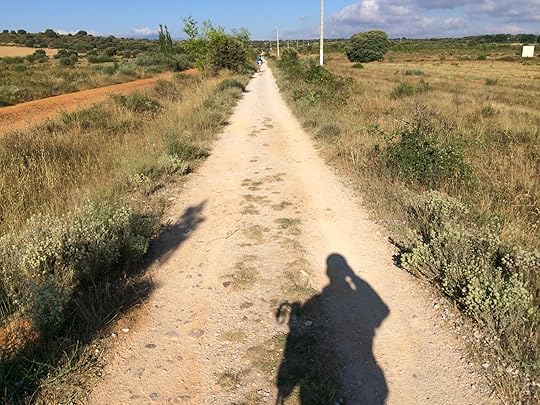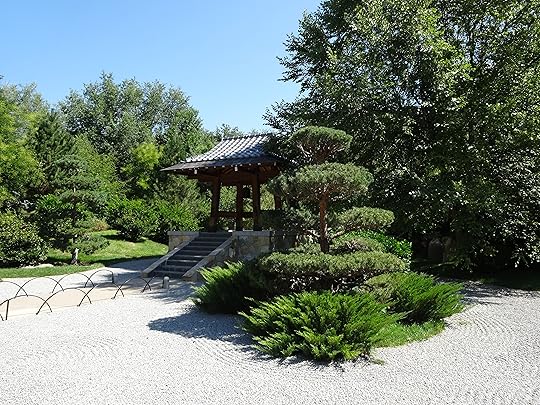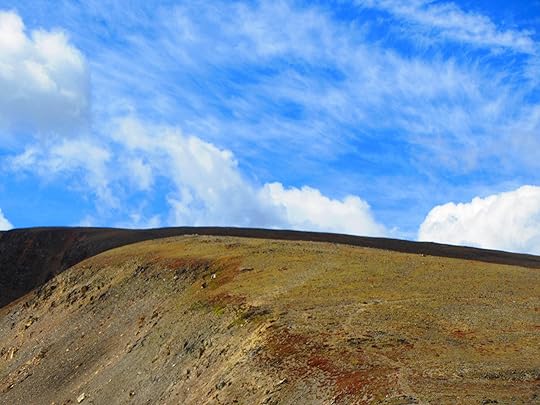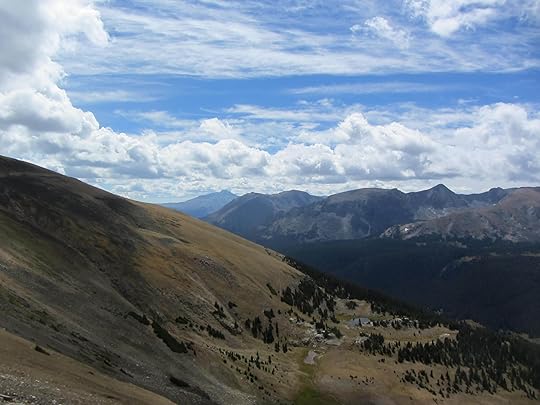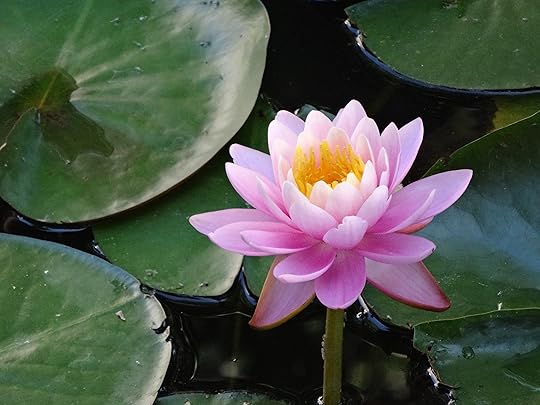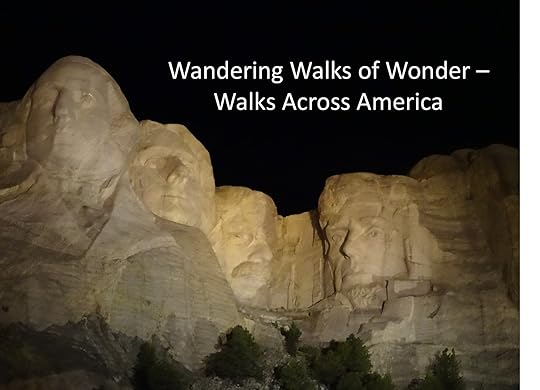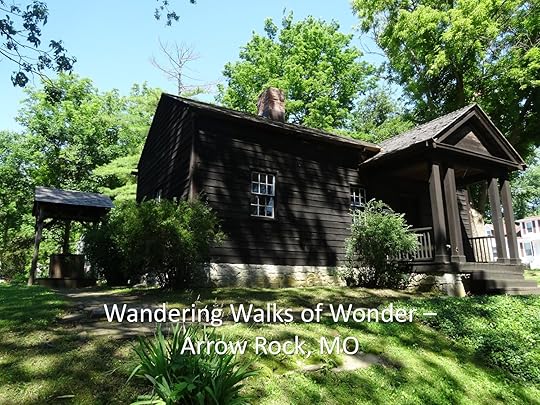Tom Alyea's Blog
October 9, 2015
Walking Alone is not Lonely
In 2014 I made the momentous decision to walk the Camino de Santiago in Spain. I’m not sure if I’ve ever been so nervous as I was in the days leading up to my departure to Spain.
But by the time my plane touched down in Madrid and I navigated by map to my hostel, then, later, to the train station for a ticket to Leon, and, later still, to pick up my pilgrims passport, my nerves were replaced by a wild sense of freedom. A journey stretched out before me. It was mine alone.
Many people have asked me why I walked the Camino alone. The answer is simple. I needed to walk alone. I lean on my spouse a lot and sometimes I wonder, too much? She’s the kind of person who will carry more than her fair share of the load without complaint. I found myself getting too comfortable with it. I was allowing her to do things for me that I should have been doing for myself. I needed to prove to myself that I could thrive on my own. And I did.
I wanted to then, and I still want to now, answer the question: What did I learn? But it’s a hard question to answer. Perhaps you’ve had the experience of visiting an ancient place or a famous landmark. You anticipate your arrival for months and you find yourself hoping you might experience special, maybe even spiritual.
But then you get there, to the Pyramids in Egypt or the Wailing Wall in Israel. It’s hot and you have to stand in line. The tour guides are hassling you. You’re uncomfortable and annoyed. You see what you have come to see but the sacred eludes you.
You leave. You walk for a while until you find a bit of shade where you sit down to rest. The world moves past you, kids in school uniforms, roadside vendors, dogs in the street. And that is when you feel it, not in the shadows of some ancient relic but in the ancient, otherworldly part of you: Every day is special.
Maybe I hoped for transcendence more than I would like to admit on the Camino. I thought, would I see God in some form? Would I know something profound at the end? Would there be a sign? Would it change my life?
I walked and I waited and I wondered why something big wasn’t happening. I was just having fun. Is fun the lesson? I wondered. I don’t want to learn about fun, I whined.
Now I see that my Camino was a journey of little moments, of small truths and simple revelations. Singing with nuns in small village church and walking into Santiago as the bagpipes wailed were moments of utter beauty to me, experiences that give me goose bumps upon remembering. But the seemingly insignificant moments stick with me just as much: the beautiful sunrises, the amazing people I met along the way, the feeling of sitting down in a café, all alone, and feeling absolutely comfortable in my own skin. I needed this pilgrimage outside of my daily comforts in order to see what was there all along.
On the Camino I mulled over my dreams and aspirations. I was lonely a little. I was awed a lot. I was me without anyone else to define or refine me. And over the miles I realized that I was truly proud of the person who was walking across Spain on his own.
Maybe it happened on the Camino or maybe it has been a work in progress since I shed the skin of my former self and decided to run towards the person I really wanted to be. But today I feel so certain of who I am. I can’t tell you what a turn of events that is for me. I did not feel that way in my old career and in my old life. Maybe it’s a byproduct of growing up and growing older or maybe it’s because I went looking for it, not just on a dusty, rocky path through Spain but on a meandering journey around the world.
September 13, 2015
Lessons Learned from Thoreau
Henry David Thoreau had a gift for turning the everyday into the extraordinary. Take walking. We do this each day. We walk to the subway, the bus, or – as most people do – our car. But it’s usually a purely pragmatic act – a way of getting somewhere or working out. But for Thoreau, walking was a philosophical, even spiritual, act.
Thoreau devoted an entire essay called “Walking” to the subject. Here, he takes on the tone of an extremist. He explains that there’s a big difference between real walkers and wannabes. He calls real walking sauntering. Real walkers don’t walk for transportation or fitness. They walk to experience a mixture of spiritual ecstasy and inner warfare: “every walk,” he says, “is a sort of crusade.”
Wannabe walkers take two forms. The first consists of idlers. “Idlers” sit still in their houses, never exploring nature on their own two feet. Then there are the “faint-hearted…vagabonds.” Vagabonds walk, but for the wrong reasons. Some walk to tour the countryside, “where half the walk is but retracing our steps.” Others – Thoreau calls them “dumbbell swingers” – walk to get a workout.
I’m normally not a huge fan of any form of extremism, and I’m a bit of a dumbbell swinger when it comes to walking. But, I propose that we explore Thoreau’s radical practice of walking philosophically.
This is no easy task. In “Walking,” Thoreau outlines three key principles that real walkers must follow:
The Tree Climbing Principle –Thoreau recommends: “to elevate ourselves a little more…we might climb a tree.” Apparently, he found himself – in all senses – on the top of a pine tree on a June day in Concord. You may not be physical able to climb a tree, but find one that ‘calls’ out to you and sit as close as you can to it.
The Magnetism Principle – This one’s tricky. Most walkers follow a trail or a plan. Thoreau rejects this practice. Following plans, maps, and trails is what tourists do, not walkers. Real walkers, says Thoreau, move according to “the subtle magnetism in Nature.” If we “unconsciously yield to it,” Thoreau says, this magnetic force of nature will “direct us aright.” This should make things interesting as you walk.
The Time Principle – A 20-minute walk through the neighborhood won’t do. Instead, Thoreau places a time constraint on aspiring walkers: “I think that I cannot preserve my health and spirits,” he says, “unless I spend four hours a day at least…sauntering through the woods.”
As your walks progress, it may not hurt to follow these principles, though I believe many may have to cheat on the last one. For most of us, strict adherence to the time principle is impossible. However, plan to walk each day and to explore Thoreau’s practice of walking philosophically.
If you believe Thoreau, this practice offers huge benefits. For one thing, he says that it brings us in touch with “wildness.” When we explore areas “not yet subdued,” we drop into a deeper level of awareness, beneath our thoughts and stories about the world. This “wildness” leaves us “alive” and “refreshed.”
He also says that this practice draws us into the present moment. The cool breeze, the sunset, and the sound of birds chirping – all of these events happen in the moment. In Thoreau’s words, their “philosophy comes down to a more recent time than ours.”
That’s what happened for Thoreau. Now let’s see what can happen for us.
August 23, 2015
What’s in Your Backpack?
Where are you going? Where are you headed? And what are you carrying with you?
What’s in the backpack of your life?
Do the burdens you choose to carry with you in your life make the walking easier or harder?
Have the commitments you’ve made on your time, talents, and abilities burdened you more than they are worth? Or do they set you free and allow you to soar free in some form of expression that would otherwise be denied you?
EVERYTHING in your life you carry with you: people, places, things, commitments, responsibilities, inadequacies, strengths, and weaknesses. All of these things take shape in our lives as the things and commitments we choose to fill our lives with. The more things we carry the heavier our load and fewer options we have when it comes to distance and freedom of travel. The more commitments we take, which consume our time and resources, both of which are limited, the more we define our lives. And ultimately owning things is a commitment of our time and resources for do we not have to upkeep, store, protect and preserve our things?
EVERYTHING we carry with us represents a commitment of our time and resources. When backpacking we commit our energy to carry, with each step, the burden we have placed upon our back. It is the same in life.
I am not advocating that you have no things or that you strive to have no commitments on your time or resources. What I am asking you to consider is the weight of these things in your life. How much of your time and resources do those things and commitments consume? Is it worth it? Do they lead you towards the expression and realization of your dreams in life? Do they lead you towards the destination of your heart? Do they allow you the freedom to enjoy the journey as you go or do they trap you within the requirements of their needs?
No matter where we go our problems will follow us. We carry them with us, and they are represented by the things and commitments we choose to carry in our lives. That which we carry with us shapes us just as surely as a potter shapes his clay.
In 2014 I hiked what is called the Camino de Santiago in Spain. Along the way I learned many lessons which have served me well over the years. Of all the lessons I learned, this was the most important: What I choose to carry changes the experience of my walking.
If I choose to carry many things, that I may at some point want or need, I simultaneously choose to commit myself to a slower, harder, journey carrying those things.
If, conversely, I carry only what I truly need and release my attachment to all those other things that, while they may be very beneficial or useful in some way, even comforting, truly do nothing but slow me down and make my burden heavy.
When we lighten our load we hike with a joyful bounce to our step. When we release the burdens of our past, and set down the unnecessary burdens we place upon our own futures, we discover quickly that our joy is increased.
The question I ask you to consider is: Do the things and commitments of your life that you have chosen to carry serve you or hinder you in the pursuit of your destiny? Are the benefits provided worth the costs?
If they are then please continue to carry them! If they are not, let them go and move forward with renewed vigor, and a lighter pack, towards the destiny of which you are a part.
August 4, 2015
A Push to the Top
I remember one of my very first hikes. I was in Yellowstone National Park and had met Joe while eating dinner at the lodge. I’m wasn’t much of a hiker back then, in fact I flat out told him I wasn’t even sure if I would like hiking. But it was a chance to hang out with a new friend and get in a little exercise, so we set out to hike Mt. Washington. I didn’t realize I was also in for a lesson on leadership.
Part of the way into the hike, my non-hiker nose was running hard. I realized I had the wrong shoes. It was hot out. I had plenty of excuses. But I guess I had something to prove. To whom I don’t know, I guess myself. I knew I could do it. I ended up walking at a faster pace than my new friend, and being the type of person he was, he told me to ‘go ahead’. So I did. As I kept hiking, I wondered why… I could have stopped. It would have been easier.
As I continued on, I felt bad. I had let my new friend down. When I hit the summit, I was proud of what I had done. I knew starting out that it would physically challenge me, but I never doubted that I could do it. What I didn’t like though was being up there alone. I texted Joe to see where he was. He replied that he couldn’t go any further and would wait for me back at the trailhead. He then asked if I was at the top. I told him I was and he gave me a virtual high five (what a great friend). Why didn’t I stop when he did and encourage him to advance up the mountain with me? I don’t know. I sure had thought about that a lot on my way up and down again to where I met him on the trail.
This really made me consider. Was this how I show up in life? I set goals, I set out to accomplish them and I do it no matter what the sacrifice. Yep, sums me up pretty good. When I look at my role as a manager and as a role model to others, I know I am there for people. I provide encouragement, I lead by example and often times I hold people’s hands. This last one – holding someone’s hand is definitely where I can grow. I want to breed independence with those I’m trying to teach and mentor, but then I also want to do it with them – not just lead them.
There’s no time like the present, right? So here is what I did. When I made it back down the trail and met Joe I looked at him and said “alright let’s head back up.” He looked at me and said OK. I didn’t say much else on our way up. It was getting hotter and my legs were getting tired, but I kept going. I wanted to do this WITH him.
We made it to the top and it was a delightful accomplishment for both of us, to do this together. To PUSH past our limits. On the way down I asked Joe why he had stopped earlier. He said he had some cramps and mentioned that he felt like he was holding me back because my pace was faster than his. I had to stop to think about that, when Joe told me to continue on – I didn’t pause to ask any questions. I learned after the fact that I could have slowed down and we could have done it together the first time.
I also asked Joe why he had waited for me to come back down. Why didn’t he keep going? He replied that he thought that he couldn’t do it. But then I got to say, Well, that isn’t true, YOU JUST DID IT. We joked about that Seinfeld episode where George does the opposite of everything he would normally do and marveled at the success that brought him. Sometimes that silly voice inside our heads that tells us we aren’t good enough, or that we can’t do something, needs to be annihilated and we need to do the VERY OPPOSITE of everything it has us thinking we should do.
It would have been great to have climbed up together the entire way. But the lessons we both learned on the trail are priceless. I learned that communication is KEY and encouragement and support are gifts I have to give. I do lead by example, but often times I don’t do enough to ensure that the others think they can do it. I didn’t set out that morning to learn or teach anything. But both Joe and I walked away with so much.
July 21, 2015
Listen to the Woods
I’ve always seen the woods and walking in the woods as a metaphor for life. We start on a path, not always sure of the direction, we face obstacles and detours on some paths, and, in the end, we reach the end of the trail.
Every now and then, people are put on our path to guide us as well. I know there are times when the path, or the people on our path, can lead us astray. But, rather than think of this as a negative, I look at being lost in the woods on a path as the first step to get me where I need to go.
Every path has one thing in common – it starts in one place and ends in another. Whatever you take (or whomever) will determine your journey’s end.
Distracting thoughts will argue you aren’t getting very far. Keep these thoughts at bay by saying to yourself “it depends on where I’m wanting to go.” Maybe this path your own today you don’t want to do quickly. Maybe this path today is one where you want to savor the journey – to literally stop and smell the roses.
Distracting thoughts will say you are going in the wrong direction. I say it’s better to get lost on my way as I head towards trails end than to stay lost going nowhere. Every single step on the trail will draw me closer to something familiar and reassure me I’m headed in the right direction.
Supporting thoughts provide that reassurance. Those thoughts encourage me. They even sometimes run ahead on the trail, just out of view, assess the situation, and then reappear to help me and adjust my route. They offer emotional support to go the distance.
Encouraging thoughts respect my experience and perspective. Those thoughts know I’ve traveled through uncharted territory before and made it thought just fine. Encouraging thoughts admire my passion and trust the trail I’m on.
Listen to the woods. Take those distracting thoughts, learn from them, then dump them in the trash bin. Take those supporting thoughts to prove the reassurance that all is well and all is fine. And as you do your own wandering walks use the encouraging thoughts to allow you to take just one more step forward in life. Life is all about just taking that one more step.
July 17, 2015
A Wandering Walk Through Hannibal, MO
This past weekend I traveled to Hannibal MO as I worked on my first Wandering Walk Guide Book. This will be a series of books that will contain self-guided walking tours, historical, information, and fun facts as I travel across the US. What better place to start this project tha in the hometown of my most favorite author – Mark Twain!
As I work with the publisher to finish the final edits and get this first guide book ready for publication in the next 2 weeks, I hope you enjoy this video which highlights many of the stops along the way in Hannibal, MO. Hannibal is beautiful in the Fall and I hope you can add this to your travel tours in the upcoming months.
July 13, 2015
A Guide to Your First Walking Meditation
A Walking Meditation is a wonderful way of transforming something that we do every day into a deeply healing, deeply nourishing and enjoyable tool for our awakening. It is a practice found both in Taoist and Buddhist traditions. When we practice a walking meditation, each step of our journey becomes the destination – which is peace and joy in our lives.
Here’s how to do a walking meditation:
It’s wonderful to practice a walking meditation any time that we are walking. When we’re first learning the practice, however, it’s best to set aside a particular time for it – say, first thing in the morning, or during your lunch break, or right before bed at night.
A Walking meditation can be practiced indoors or outside. When the weather is nice, I like to practice outside, where I can be energized by the trees and sky. It’s good to either go bare-foot (especially if you are inside) or wear shoes that give your feet and toes plenty of room to spread out.
Now, simply stand with your spine upright and your shoulders relaxed, letting your arms hang naturally by your sides. Take a couple of long, slow and deep breaths. As you exhale, let go of any unnecessary tension, smile gently, and let your attention flow deep into your belly, hips, legs and feet. Relax your pelvis, as though you had just mounted a horse. Feel your connection to the earth.
Next, begin to coordinate your breathing with taking small steps: as you inhale, step forward with your left foot; as you exhale, step forward with your right foot; and continue in this way. Let your gaze be focused gently on the ground in front of you. You can also experiment with taking several steps with the inhale, and several with the exhale. But keep the pace quite slow (slower than your normal walking pace) and relaxed.
As you become comfortable coordinating your breath with walking, try adding this beautiful visualization: Each time you place one of your feet down, imagine that you are kissing the earth, through the sole of your foot. Each time you pick up one of your feet, imagine that a beautiful pink/white lotus is now blossoming in the place that your foot just was. In this way, our walking becomes a way of expressing our love for the earth, and of creating beauty with each step.
Walk this way – slowly, enjoying each step, with no thought of “getting somewhere” other than right where you are, here and now – for ten minutes or longer. Notice how you feel.
Little by little, incorporate this practice into your daily life – taking three or four slow, mindful steps, kissing the earth, whenever you think of it. Notice how this changes the quality of your day.
Tips:
Don’t worry if this kind of walking feels awkward at first. We’re learning to pay close attention to something that we’re not used to paying close attention to. Little by little, it will start to feel quite natural.
When you stretch out your feet and toes completely, and let the entire bottom of your foot be in contact with the ground, nerves, arteries and meridians connected to the entire body are stimulated – which is very beneficial for our health.
Let your mind be focused and relaxed. If it wanders into thoughts of past or future, simply come back to the practice.
What You Need:
A human body.
A pleasant place to walk – either indoors or outside.
July 3, 2015
Wandering Walks Across the US – A 4th of July Special
I have been blessed to have walked throughout many fantastic and wonderful sights throughout the US over the years. This video highlights many of those walks and sights across the United States. Happy Independence Day 2015!
June 30, 2015
Walking in the Shoes of Others
Travel is vital for a healthy sense of perspective. And I don’t mean tourist-type travel…the kind where you stay at a fancy hotel, visit an amusement park or two, meet and speak with only your waiter or waitress at a trendy, or worse, chain restaurant. I have found during my travels to explore wandering walks around the world that it’s important to get into the real heart of the land you are visiting – be it a small town an hour away from your home or across the ocean to another country. To really get to know the world you need to spend time speaking to the people who live in the world.
It’s a wonderful experience to speak with others in another area of your country, to get their take on how they see the world, your city, your country. It’s exciting to see how families treat their spouses, children, and elders. Maybe they have better ways than you do. Maybe you can confirm your ways are just fine. Take time, as you wander around, to appreciate how others keep their pets, farms, and businesses.
Every year this world is shrinking; there’s no longer any excuse for xenophobia or “my culture’s ways is THE right way!” thinking. We all have to live on this planet. Understanding and respect for differing viewpoints, traditions, and lifestyles is the only way we will all get along and, ultimately, survive.
We’ve often heard the saying to “walk in another’s shoes” – but we don’t ask ourselves why that is important. I love traveling to other countries and “walk” in their shoes for a while. I love heading out two hours away to see how others in towns much different than my own see the world. It’s through this kind of walking – walking in the shoes of those whose lifestyle and culture is much different than my own – that I can learn new, more fulfilling, and life-altering experiences that help me to grow as a person.
My wanderings around my country, or any other country, may not change the world. But, it will help me to understand that everyone has a unique place on this plant and only by working (and walking) together will we help this planet to evolve into something greater than it is today.
June 26, 2015
A Wandering Walk Through Arrow Rock, MO
Arrow Rock is a village in Missouri located near the Missouri River. The village has important historical significance related to westward expansion, the Santa Fe Trail and the 19th century home of artist George Caleb Bingham.
The village retains much of its 19th century character and is recognized as the birthplace of historic preservation in Missouri.

